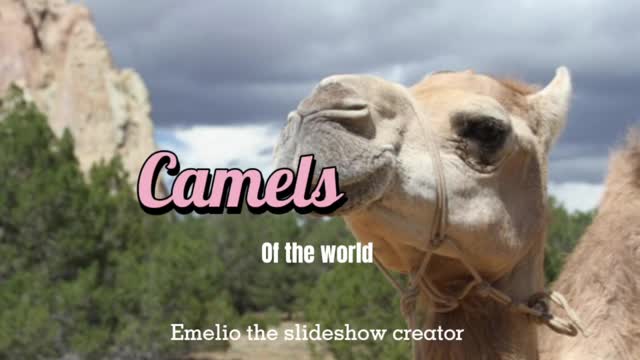Premium Only Content

Video tribute to all Camels 🐪 in the world. Nature at its best.
Video tribute to all Camels 🐪 in the world. Nature at its best.
How do camels adapt to the desert environment?
#camels #camelshortsvideo #animals #nature #desert #shorts #youtubechannel #subscribe #twitch #like #instagram #share #contentcreator #Bactriancamel #camelsvideo #africa #saudiarabia #Arabia #mongoloancamel #kids #kidsvideo #kidsanimalsvideos #iraq #iran #middleeast #rumble #youtuber #youtube #instagram #twitter #facebook #wikipedia #biography
Camels 🐪 Wikipedia
A camel (from: Latin: camelus and Greek: κάμηλος (kamēlos) from Hebrew or Phoenician: גָמָל gāmāl.[7][8]) is an even-toed ungulate in the genus Camelus that bears distinctive fatty deposits known as "humps" on its back. Camels have long been domesticated and, as livestock, they provide food (milk and meat) and textiles (fiber and felt from hair). Camels are working animals especially suited to their desert habitat and are a vital means of transport for passengers and cargo. There are three surviving species of camel. The one-humped dromedary makes up 94% of the world's camel population, and the two-humped Bactrian camel makes up 6%. The Wild Bactrian camel is a separate species and is now critically endangered.
The word camel is also used informally in a wider sense, where the more correct term is "camelid", to include all seven species of the family Camelidae: the true camels (the above three species), along with the "New World" camelids: the llama, the alpaca, the guanaco, and the vicuña, which belong to the separate tribe Lamini.[9] Camelids originated in North America during the Eocene, with the ancestor of modern camels, Paracamelus, migrating across the Bering land bridge into Asia during the late Miocene, around 6 million years ago.
-
 22:45
22:45
Brewzle
18 hours agoI Went Drinking In A Real Bourbon Castle
37.7K3 -
 48:36
48:36
PMG
1 day ago $2.69 earned"Parkland Parent Speaks Out On Kamala Harris Using Victims"
30.1K4 -
 4:06
4:06
The Lou Holtz Show
16 hours agoCoach Lou Holtz’s Heartfelt Christmas Message 🎄 | Family, Faith & Notre Dame Spirit 💚 #christmas
22.3K -
![ROSEANNE BARR - Her Journey, TRUMP, and the MAGA GOLDEN AGE! [INTERVIEW]](https://1a-1791.com/video/s8/1/M/m/B/2/MmB2v.0kob.1-small-ROSEANNE-BARR-Her-Journey-T.jpg) 51:35
51:35
Dr Steve Turley
1 day ago $19.18 earnedROSEANNE BARR - Her Journey, TRUMP, and the MAGA GOLDEN AGE! [INTERVIEW]
57.2K54 -
 57:38
57:38
The Tom Renz Show
14 hours agoMerry Christmas - The Tom Renz Show Christmas
93.4K17 -
 2:59:10
2:59:10
Wendy Bell Radio
1 day agoThe Bridge Too Far
171K301 -
 1:03:45
1:03:45
Donald Trump Jr.
1 day agoHappy Festivus: Airing Our Grievances and Stopping The Swamp w/Sean Davis | TRIGGERED Ep.201
430K549 -
 1:30:30
1:30:30
Game On!
1 day ago $8.09 earnedTop 5 things you need to know for Sports Christmas!
75.8K5 -
 1:58:10
1:58:10
Robert Gouveia
1 day agoMatt Gaetz REJECTS Report, Sues Committee; Luigi Fan Club Arrives; Biden Commutes; Festivus Waste
299K240 -
 1:31:40
1:31:40
Adam Does Movies
1 day ago $16.44 earnedThe Best & Worst Christmas Movies! - LIVE!
118K8